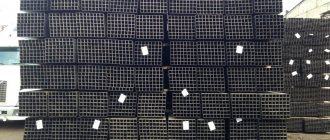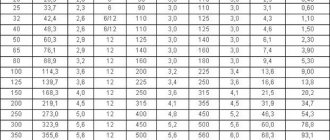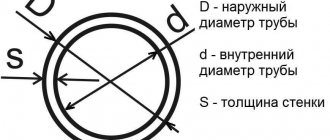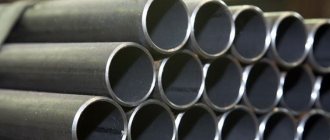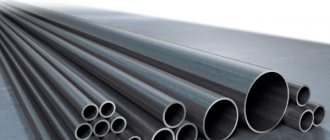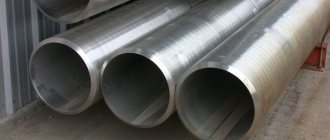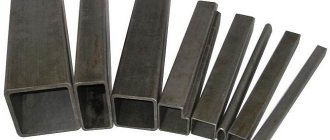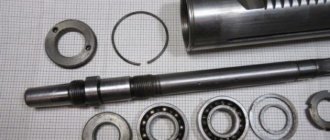Steel pipes are used very widely in industry and everyday life. It is used when laying closed and open communications supplying gases and liquids to distribution stations. Steel products are used to protect power and signal cables in the aircraft and automotive industries.
Steel pipes serve as structural and decorative elements in a number of areas. In everyday life, water supply and heating systems are assembled from them. The products have high physical characteristics, withstand significant operating loads and reliably serve for many years.
Steel 13HFA
High-quality alloy structural steel.
Type of delivery : pipes made of steel 13xfa
Application: For the manufacture of pipe blanks intended for the production of seamless hot-deformed oil and gas pipeline pipes with increased corrosion resistance and cold resistance, intended for use in gas transporting systems, oil and gas pipeline systems, technological field pipelines transporting oil and petroleum products, as well as in systems for maintaining reservoir pressure in northern climatic conditions zones at ambient temperatures from -60°С to +40°С, temperatures of transported media from +5°С to +40°С and operating pressure up to 7.4 MPa. The pipes differ from conventional oil and gas pipelines in accordance with GOST 8731, GOST 8732, by increased cold resistance, increased resistance to general and pitting corrosion, resistance to sulfide corrosion cracking and the formation of hydrogen cracks.
Electric welded pipes
Electric-welded pipes are pipes that are used to transport water, gas, and other substances. They are produced by such methods as: forging, pressing, rolling, drawing. There are straight-seam and spiral-seam pipes.
Straight-seam pipes have the following differences:
- lower cost;
- large assortment;
- versatility.
Spiral welded pipes are designed for use in seismic zones. The structures made from such products are very durable. Spiral welded pipes are produced in exceptionally large diameters. Such products are much more expensive than straight-seam pipes.
Electric-welded pipes get their name from the installation method: during the installation process, the pipes are connected to each other using electric welding.
Steel 12Х1МФ
Low-alloy, heat-resistant structural steel. Pearlitic grade steel. Recommended application temperature up to 570-585 °C; Temperature of intensive scaling 600 °C; operating life - more than 10,000 hours.
Substitute: 12ХМФ.
Type of supply: Pipes TU 14-3р-55-2001, including long and shaped steel.
Application: For superheater pipes, pipelines and high pressure manifold installations; forgings for steam boilers and steam pipelines; gas turbine cylinder parts; for the manufacture of parts operating at temperatures of 540-580°C.
Useful little things
Since we are discussing steel pipes, it is logical to touch on several related topics that will probably be of interest to many readers.
- The service life of steel pipes greatly depends on their operating conditions . It is minimal for a black pipe in cold water in the absence of an anti-corrosion coating. After just ten years, the pipes significantly reduce their permeability due to overgrowing, and the pipe threads (in the cavities of the threads the wall thickness is minimal) begin to leak.
On the other hand, the service life of water pipelines made of corrosion-resistant steel is practically unlimited, and black steel on gas pipelines, where there is no dampness or aggressive environments, can also last for centuries.
The gas pipe is in favorable conditions and can function for a very long time
- The main producers of steel pipes in Russia: Volzhsky Pipe; Taganrog Metallurgical; Sinarsky trumpet; Seversky Pipe; Pervouralsky novotrubny; Chelyabinsk pipe rolling and Vyksa metallurgical plants.
- Cutting steel pipes at home is most often carried out with a conventional turbine with a metal cutting wheel . Nobody canceled the hacksaw either. However, manual and electric pipe cutters are more convenient in that they cut the pipe strictly perpendicular to its axis. In addition, the end of the pipe after the pipe cutter is already slightly rolled, which is very convenient for manual thread cutting.
- If you have to weld a pipeline from a thick-walled pipe, a chamfer for steel pipes will also be a very useful tool. It can be either electric or manual.
Why is it needed? The fact is that a thick-walled pipe welded without chamfering will be no stronger than a thin-walled one. A seam that does not weld the entire thickness of the pipe will inevitably turn out to be a weak point.
The simplest manual chamfer looks like this
- The marking of steel pipes contains the trademark or name of the manufacturer, pipe size and steel grade . It can be applied by branding or indelible paint. However, do not look for this information on water pipes of small diameters: according to GOST 10692-80, only pipes with a diameter of 159 millimeters and a wall thickness of 3.5 mm are marked.
- Factory-made fasteners for steel water pipes are a galvanized clamp with a rubber gasket . The use of plastic fasteners is also possible; however, if the pipe is fixed even slightly under tension, such fasteners will not last long.
- The roughness coefficient of a steel pipe varies greatly during its operation. In hydraulic calculations, for a new and clean steel pipe it is taken equal to 6, and for a heavily rusted one - 200.
Threaded connections of steel pipes are best sealed using plumbing flax, red lead and natural drying oil; however, linen with nitro dye will also work.
The assembly of the connection after the valve with the discharge in this case looks like this:
- Hand-tighten the locknut and coupling;
- Using a brush, apply a small amount of paint to the short thread of the drive;
- Clockwise, wind the thread with a thin strand of pure flax without straw or debris;
Wind a strand of flax like this. Don't forget the paint
- Before making the last turn of the winding, apply a little more paint around the circumference directly onto the winding. A little!
- Carefully, trying not to get dirty, we wrap the thread;
- We screw the drive into the valve first by hand, and then with a pipe wrench; at the same time, at the last revolutions, be sure to hold the valve with a second key so as not to turn it;
- We wind up the thread on the liner from the side of the outlet opposite the valve in the same way;
- We drive the coupling onto the liner; if the axes of the pipes do not coincide, you may have to do this by stretching. We tighten it;
- We drive the locknut, stopping about 10 millimeters before the coupling;
- We wind up the threads between the coupling and the locknut with paint in the same way as the previous threads;
- Tighten the locknut. Made!
Please note: it is better to lay a piece of polyethylene on the floor. Even a small excess of paint will be squeezed out of the rewind and leak.
If you need to connect an automatic washing machine, but don’t want to call a plumber, a saddle will help - a fitting for connecting the outlet.
- Carefully remove paint and rust, achieving the smoothest possible surface of the pipe;
- Turn off the water and make sure there is no pressure in the line;
- Place a basin or bowl under the place chosen for drainage - there is probably some amount of water in the pipe;
- Drill a hole in the pipe wall in the direction where the outlet will face;
- Turn on the water briefly so that the chips fly out;
- Install the saddle so that the outlet is directly opposite the hole in the pipe;
- Install the valve. It is advisable that the washing machine be turned off separately.
- Plug in the machine and wash to your heart's content.
The saddle will significantly simplify the drainage of water to a new plumbing fixture or washing machine.
Steel 15GS
Low-alloy structural steel for welded structures.
Substitute: 12GS, 16GS.
Type of supply: Boiler pipes according to TU 14-3r-55-2001.
Application: Stationary feed water pipelines of SVP boilers operating at a temperature of 280°C. As well as truss posts, top frames of cars, center beams, I-beams and other parts of car construction, parts of excavators, elements of welded metal structures and other parts operating at temperatures from -40 to +450°C.
Assortment of square steel pipes, according to GOST 2591-88 (2006)
Rectangular and quadrant types of steel pipes are not often used for transporting water and gas: their use is mainly concentrated in the construction industry, where load-bearing and supporting elements are assembled from them. Profiles with thin walls are often used in the furniture and advertising industries. The indicator on which the quality of a square steel pipe directly depends is its weight. This parameter is also specified in GOST 2591-88 (2006): the mass of one meter of a linear product should be from 0.269 kg for thin-walled pipes, and 70.33 for the thickest-walled ones. In this case, the density of the black steel used in this case is 7.85 g/cm3.
GOST 2591-88 (2006) also stipulates that square products must have a curvature not exceeding 0.5% of the length for pipes with a diameter of 25 mm, and 0.4% for other products. Sometimes the customer wants to reduce this parameter to a value of 0.2%. On the sides for square rolled products, deviations are allowed both in the direction of increase and decrease. Standard profile dimensions can undergo minus deviations from -2.5 mm (products of large dimensions, where the square side has an indicator of 200 mm) to – 0.5 mm (this applies to square pipes with thin walls, having side dimensions of 13-25 mm ). As for positive deviations, this is from + 0.9 to + 0.3, respectively. To define closed square pipes made of cold-worked steel, GOST 12336-66 is used.
The classification of rectangular metal pipes is carried out by GOST 8645-68. This standard provides for hot-rolled, cold-drawn and seamless manufacturing methods. Structures without seams have the greatest strength: an obstacle to their mass use is their high cost. For the production of shaped square and rectangular steel pipes, GOST determines the predominant use of the welded method. With the help of modern technologies, it has become possible to adjust the strength properties of the seam, for which induction currents are used. It is noteworthy that this does not lead to higher prices for products. Special treatment may be used for welds, or they are left in an uncleaned state: this is influenced by the characteristics of their subsequent operation.
The same principle is applied in the manufacture of galvanized profile pipes: the initial raw material is a steel strip with a protective coating. Although in certain situations, finished products are galvanized, for which they are immersed in molten zinc: this procedure is repeated several times. According to GOST, rectangular steel pipes are not classified depending on the grade of steel used.
The document allows for the possibility that the profile pipe is made from black steel, which is not as presentable and resistant to corrosion than more expensive brands. For steel rectangular pipes, GOST 8645-68 allows for different sizes. The most popular according to the smaller side are pipes of 40 mm, on the larger side – from 60 to 100 mm. The latter option is characterized by high bending strength qualities, in parallel with a fairly low mass: this is what explains their high popularity in the engineering and construction fields.
Steel 30HGSA
Structural alloy steel. Chrome-silicon-manganese steel.
Substitute : 40HFA, 35ХМ, 40ХН, 25ХГСА, 35ХГСА.
Type of delivery: seamless hot-rolled pipes
Application: Various parts to be improved: shafts, axles, gears, flanges, casings, compressor blades operating at temperatures up to 200°C, levers, pushers, critical welded structures operating under alternating loads, fasteners operating at low temperatures .

